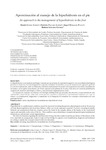Mostrar el registro sencillo del ítem
Aproximación al manejo de la hiperhidrosis en el pie
| dc.contributor.author | López-López, Daniel | |
| dc.contributor.author | Palomo-López, Patricia | |
| dc.contributor.author | Morales-Ponce, Ángel | |
| dc.contributor.author | Sánchez Gómez, Rubén | |
| dc.date.accessioned | 2022-02-09T08:18:28Z | |
| dc.date.available | 2022-02-09T08:18:28Z | |
| dc.date.issued | 2013 | |
| dc.identifier.citation | López López, D., Palomo López, P., Morales Ponce, A., & Sánchez Gómez, R. (2013). Aproximación al manejo de la hiperhidrosis en el pie. Revista Internacional de Ciencias Podológicas, 7(2), 89-97. | es_ES |
| dc.identifier.issn | 1887-7249 | |
| dc.identifier.uri | http://hdl.handle.net/2183/29737 | |
| dc.description.abstract | [Resumen] La hiperhidrosis es un trastorno patológico causado por un aumento de sudoración superior a las necesidades fisiológicas precisas en el proceso de termorregulación corporal y al balance electrolítico, ya sea de manera local, regional o general. La excesiva sudoración, suele ser bilateral y simétrica relativamente frecuente a nivel general en las axilas, las palmas de las manos, en la región craneofacial y de forma especial en las plantas de los pies. Esta afección ocasiona perturbación ocupacional, deterioro psicológico y físico, y una potencial estigmatización social.La carencia de consenso en relación a la etiología multifactorial que presenta esta afección y la prevalencia de esta enfermedad a nivel del pie, sobre todo en los jóvenes, nos lleva a mejorar los conocimientos existentes en lo que se refiere a su clasificación, diagnóstico y tratamiento en la búsqueda de actualizar los conceptos relacionados con esta patología del pie. | es_ES |
| dc.description.abstract | [Abstract] Hyperhidrosis is a pathological condition caused by increased sweating than precise physiological needs in the process of body thermoregulation and electrolyte balance, either on a local, regional or general. Excessive sweating is usually bilateral and symmetrical relatively common across the board in the armpits, palms of the hands, in the craniofacial region and especially on the soles of the feet. This condition causes disturbance occupational psychological and physical deterioration, and potential social stigmatization.The lack of consensus regarding the multifactorial etiology has this condition and the prevalence of this disease at the foot, especially in young people, leads to improved knowledge in regard to their classification, diagnosis and treatment in seeking to update the concepts related to this foot disorders | es_ES |
| dc.language.iso | spa | es_ES |
| dc.publisher | UCM | es_ES |
| dc.relation.uri | http://dx.doi.org/10.5209/rev_RICP.2013.v7.n2.41740 | es_ES |
| dc.rights | Atribución 3.0 España | es_ES |
| dc.rights.uri | http://creativecommons.org/licenses/by/3.0/es/ | * |
| dc.subject | Sudor | es_ES |
| dc.subject | Hiperhidrosis | es_ES |
| dc.subject | Bromohidrosis | es_ES |
| dc.subject | Hiperhidrosis focal | es_ES |
| dc.subject | Sweating | es_ES |
| dc.subject | Hyperhidrosis | es_ES |
| dc.subject | Bromohidrosis | es_ES |
| dc.subject | Focal hyperihidrosis | es_ES |
| dc.title | Aproximación al manejo de la hiperhidrosis en el pie | es_ES |
| dc.title.alternative | An approach to the management of hyperhidrosis in the foot | es_ES |
| dc.type | journal article | es_ES |
| dc.rights.accessRights | open access | es_ES |
| UDC.journalTitle | Revista Internacional de Ciencias Podológicas | es_ES |
| UDC.volume | 7 | es_ES |
| UDC.issue | 2 | es_ES |
| UDC.startPage | 89 | es_ES |
| UDC.endPage | 97 | es_ES |
| UDC.coleccion | Investigación | es_ES |
| UDC.departamento | Ciencias da Saúde | es_ES |
| UDC.grupoInv | Grupo de Investigación Saúde e Podoloxía (GISAP) | es_ES |
Ficheros en el ítem
Este ítem aparece en la(s) siguiente(s) colección(ones)
-
Investigación (FEP) [507]






